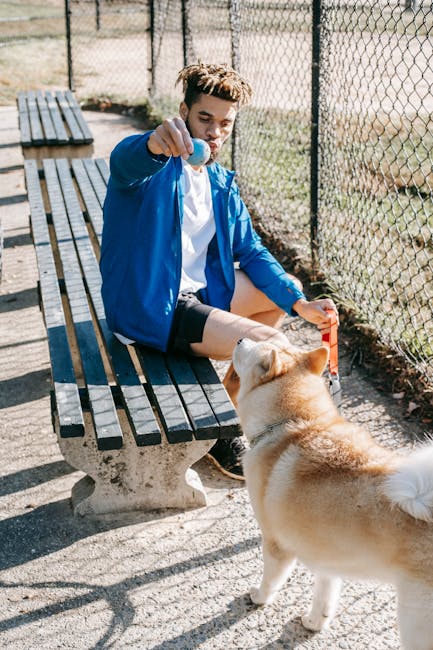Understanding the Alpha Dog: Beyond the Myth and into the Science of Canine Leadership
The term “alpha dog” has permeated popular culture, often misrepresented and misused in dog training and behavior. While the concept originated in observations of wolf packs, its application to domestic dogs is far more nuanced and complex than many believe. This article will delve into the scientific understanding of canine social structures, debunk common myths surrounding the alpha dog, and explore effective, humane training techniques based on positive reinforcement and clear communication.
The Myth of the Alpha Dog: A Misinterpretation of Wolf Pack Dynamics
The popular notion of the alpha dog, a dominant, aggressive leader ruling the pack through intimidation and violence, largely stems from flawed interpretations of studies on wolf packs in the 1970s. These early studies, often conducted in captive environments, presented a skewed view of wolf social dynamics. More recent research reveals a far more complex and collaborative social structure within wolf packs, characterized by strong family bonds and cooperative hunting strategies. There’s less emphasis on a singular dominant individual and more on complex relationships shaped by kinship and experience.
Applying this flawed ‘alpha’ model to domestic dogs often leads to harsh, aggressive training methods, causing fear, anxiety, and ultimately, a breakdown in the human-animal bond. These methods, based on dominance and control, are increasingly recognized as both ineffective and detrimental to the dog’s well-being.

Canine Social Structures: A More Accurate Perspective
Unlike wolves, domestic dogs have evolved alongside humans for thousands of years. Their social structures are profoundly influenced by their relationship with us. While dogs exhibit hierarchical behaviors within their own species, it is crucial to understand that these hierarchies are rarely based on aggression. Instead, they’re more likely influenced by factors such as age, experience, resource access, and individual personalities.
Within a household, a dog’s position within the family structure isn’t determined by aggression but by consistent, clear communication and predictable routines. This involves establishing clear boundaries, providing consistent training, and ensuring the dog feels safe and secure.
Understanding Dog Body Language
Interpreting canine body language is crucial for understanding your dog’s emotional state and social standing within the household. Learning to recognize signs of stress, anxiety, fear, and aggression can prevent misunderstandings and promote positive interactions. Some key indicators to look out for include:

- Tail wags: Not always a sign of happiness, tail wags can also indicate anxiety or uncertainty.
- Ears: Positioned forward indicates alertness, while flattened ears often suggest fear or submission.
- Mouth: Open mouth panting can be a sign of stress or fear.
- Body posture: Crouched posture and lowered head often indicate submission, while a stiff body with raised hackles can suggest aggression.
Positive Reinforcement Training: Building a Strong Bond
Instead of aiming for dominance, focus on building a positive, trusting relationship with your dog. Positive reinforcement training techniques, which reward desired behaviors, are vastly superior to punishment-based methods. Rewarding good behavior strengthens the bond and promotes a cooperative, happy canine companion.
Effective Positive Reinforcement Strategies
- Clear and consistent commands: Use simple, concise commands and ensure consistency in your training methods.
- Reward desired behaviors: Use treats, praise, or toys to reward your dog immediately after they perform a desired action.
- Patience and understanding: Remember that dogs learn at different paces. Be patient and avoid punishing them for mistakes.
- Consistency: All members of the household should use the same commands and training techniques.
- Socialization: Expose your dog to a variety of positive experiences, sounds, and people to help them develop into a well-adjusted dog.
Addressing Behavioral Problems: When Professional Help is Needed
While positive reinforcement is highly effective for most dogs, some behavioral issues require professional help. If your dog is exhibiting aggressive or destructive behavior, consult with a certified professional dog trainer or veterinary behaviorist. They can assess your dog’s behavior, identify underlying causes, and develop a tailored behavior modification plan.
The Importance of Early Socialization
Proper socialization during a puppy’s critical developmental period (typically between 3 and 14 weeks of age) is crucial for their well-being and future behavior. Positive interactions with other dogs, people, and environments will help them develop into well-adjusted, confident adults. Lack of socialization can lead to fear, anxiety, and potential aggression.
Conclusion: Redefining Leadership in the Human-Canine Relationship
The concept of the “alpha dog” is a misleading oversimplification of canine social dynamics. Effective dog training and leadership should be based on mutual respect, clear communication, and positive reinforcement. By understanding canine behavior and employing humane training methods, we can build strong, loving relationships with our canine companions. Focus on building trust, understanding your dog’s individual needs, and providing them with a safe, stimulating environment, rather than imposing dominance.
Remember, responsible pet ownership entails continuous learning and adaptation to your dog’s unique personality and needs. By discarding outdated and potentially harmful approaches like the ‘alpha dog’ myth, we can foster healthier, happier, and more enriching lives for both humans and their canine friends.


